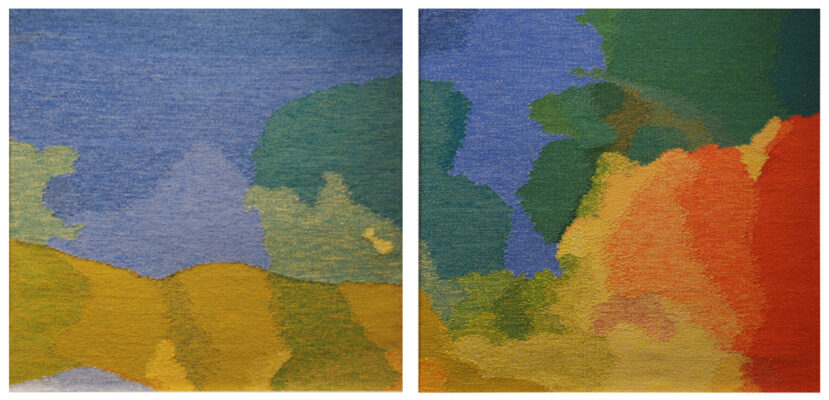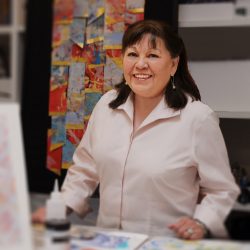One thousand years of Native American women’s art is currently traveling around the country, being featured at major museums.
“The whole idea to wipe us off the face of the Earth didn’t work,” says Anita Fields, an Osage artist in the show. “So we’re still very powerfully here.”
“Hearts of Our People: Native Women Artists” is now on view at Smithsonian Institution’s Renwick Gallery in Washington, D.C., just across the street from the White House. It’s the third stop on a tour that also includes Minnesota, Tennessee and Oklahoma.
Of course, legendary Native women artists — such as Pueblo potter Maria Martinez — have been featured in solo exhibitions, including at the Renwick Gallery. And Native women’s work has long been shown in major museums such as the Smithsonian. But that does not mean it was recognized as such.
“It wasn’t being called Native women’s art,” points out Fields. “It was: The war shirt that was worn by the warrior, and so it was named for him.”
Native women’s art was usually anonymized and identified by tribal affiliation when exhibited in museums, says co-curator Jill Ahlberg Yohe. “This was a Nez Perce object, or an Apache dress,” she explains by way of example. The names of the artists have been lost.
Yohe and co-curator Teri Greeves, who’s Kiowa, assembled an advisory board in 2014 of Native women artists, curators and scholars who selected the work represented in “Hearts of Our People,” along with some non-Native scholars. The exhibition’s art ranges from an ancient pot from 1,000 CE — presumably made by a Hohokam woman in the part of the country that’s now Arizona — to the colorful, contemporary tapestries, ruminative and reminiscent of watercolors, created by Hopi artist Ramona Sakiestewa called Nebula 22 & 23.
“I’m very interested in deep space,” Sakiestewa explains in an exhibition video. “Like the cosmos, and stars, because that’s a scientific vocabulary that indigenous people in the Americas have had. But I think everyone thinks we’re just out collecting nuts and berries, and that’s it — not that our cultures are based in really deep science.”
Or science, art and environmentalism, in the case of mother-daughter Ottawa Pottawatomi artists Kelly Church and Cherish Parrish, whose work is also on display in the show. Their family has been weaving baskets in Western Michigan for generations.
Parrish has a piece in the show that speaks directly to regeneration — the shape suggests a pregnant woman — and her mother recently won a major fellowship from the National Endowment of the Arts for her art and her activism. Kelly Church says the black ash trees her family has long harvested for their baskets have been largely destroyed by an invasive species called the emerald ash borer.
“It’s a lot harder to find our trees,” Church says, adding that her family may have to skip a generation in teaching how to weave. “I admit I go out there and I get tears in my eyes when I see all of those dead trees.”
Devastation and trauma is inevitable in art that helped people survive genocide and cultural erasure. Co-curator Jill Ahlberg Yohe — who is not native, but curates Native art at the Minneapolis Institute of Art where this exhibition first opened — points to a disturbing work called “Fringe.” It’s a life-sized, lightbox image showing a woman curled up, facing away, unconscious, and nearly nude, with an ugly gash crossing her back.
“A wound that seems so deep that it is incapable of being healed,” Ahlberg Yohe observes quietly. Anishinaabe artist Rebecca Belmore created the gash with special effects makeup and scarlet beads that look like blood. “It is stitched together through beads,” Ahlberg Yohe continues. “It is stitched together through women’s work.”
Native women face a shockingly disproportionate amount of violence, and that is what this piece reminds the viewer. More than half of Native women have been sexually assaulted, according to a 2012 National Institute of Justice study. They face some of the highest rates of domestic abuse, and on some reservations, Native women are murdered at a rate more than 10 times the national average.
“This kind of making is about our survival. That’s what I love about all these pieces here,” says Church. “They speak to that strength and resilience that we’ve had for thousands of years right up until today — and thousands of years into future.”
And this show puts Native women right where they belong, she says — credited, contextualized and celebrated in some of the most important museums in the country.
MICHEL MARTIN, HOST:
And finally today, an art exhibition at one of the oldest museums in Washington, D.C., is making history with the first major show of Native American women artists. NPR’s Neda Ulaby has this report. It’s from the Smithsonian Institution’s Renwick Gallery.
NEDA ULABY, BYLINE: Of course, Native American women’s work has been shown in the Smithsonian almost from the beginning, but that does not mean it was recognized as such.
ANITA FIELDS: It wasn’t being called Native women’s art. It was the war shirt that was worn by the warrior, and so it was named for him.
ULABY: That’s one of the artists in the show. Anita Fields is Osage, from Oklahoma. Her bright red, lavishly embroidered ceremonial wedding coat is part of a survey that begins with a thousand-year-old geometrically painted pot, presumably crafted by a Pueblo woman, to a video interview with a contemporary artist from the Santa Clara Pueblo. Rose B. Simpson painted a pickup to look like pottery.
ROSE B SIMPSON: When I was a little kid, my mom was fixing the truck. When I was a little kid, my mom was growing our food.
ULABY: This show, called “Hearts Of Our People,” celebrates traditional art forms and pushes back against the idea that Native women’s art is mostly beadwork and pottery. Ramona Sakiestewa is a Hopi artist who’s also in the video.
(SOUNDBITE OF ARCHIVED RECORDING)
RAMONA SAKIESTEWA: I’m very interested in deep space, like, the cosmos and stars because that’s a scientific vocabulary that Indigenous people in the Americas have had. But I think everybody thinks we’re just out collecting nuts and berries and that’s it, not that our cultures are based in really deep science.
ULABY: The exhibition is co-curated by Kiowa artist Teri Greeves.
TERI GREEVES: Really, from the moment I was born, I didn’t understand anything other than Native women being, you know, main creators of our art.
ULABY: She says she’s been preparing for it since she was a girl on the Wind River Reservation in Wyoming.
GREEVES: My mother ran a trading post, and it was mostly women that she dealt.
ULABY: Women selling their art and passing on cultural knowledge to their children. That legacy lives in this show with an Ottawa Potawatomi artist named Cherish Parish from Western Michigan.
CHERISH PARISH: My mom really pushes the idea that, you know, I’m a sixth-generation basket weaver, but we’ve been doing it for years and years before cameras were even invented as well.
ULABY: Her mom is here at the museum. Kelly Church recently won a major fellowship from the National Endowment for the Arts. She says the black ash trees her family’s always used for their baskets have been largely destroyed by invasive species, so her grandkids might not learn the craft.
KELLY CHURCH: We still harvest. We still teach. But it’s a lot harder to find our trees. And we’re possibly going to have to skip a generation. And when you go to a ash stand, I’ll admit, you know, I go out there and I – I’ll get tears in my eyes when I see all of those dead trees.
ULABY: Devastation and trauma are inevitable in art that’s helped people survive centuries of genocide and cultural erasure. Jill Ahlberg Yohe is the show’s other curator. She is not Native, but she curates Native art at the Minneapolis Institute of Art, where this traveling exhibition started. Yohe points to one disturbing image, a life-sized lightbox photo of a woman lying curled up, facing away, seemingly unconscious and nearly nude.
JILL AHLBERG YOHE: And a large gash crosses her back, a wound that seems so deep that it is incapable of being healed.
ULABY: It looks real, but it isn’t. Artist Rebecca Belmore, who’s Anishinaabe, created the gash with special effects makeup and scarlet beads that look like blood.
YOHE: It is stitched together through beads. It is stitched together through women’s work.
ULABY: And it speaks to the disproportionately high rates of violence faced by Native American women, says artist Kelly Church.
CHURCH: This kind of making is about our survival. That’s what I love about all these pieces here. They speak to that strength and the resilience that we’ve had for thousands of years right up until today and thousands of years into the future.
ULABY: For now, artist Anita Fields says this show puts Native women right where they belong – with credit and context in some of the most important museums in the country.
FIELDS: You know, the whole idea to wipe us off the face of the earth didn’t work. And so, you know, we’re still very powerfully here.
ULABY: Being here in the nation’s capital is great, Fields says, but it’ll mean even more to her when the show travels next to her home state to the Philbrook Museum of Art in Tulsa, Okla.







